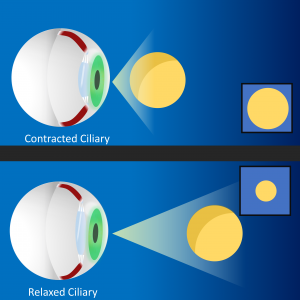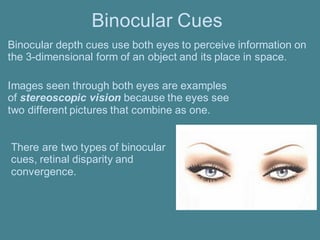Which of the Following Depth Cues Requires Two Eyes
Binocular cues require that we use both eyes. Convergence and divergence are important to depth perception because they are used to place the two images of a feature in the world on corresponding locations in the two.
Openpsyc Introduction To Psychology Depth Cues
Visual distance and depth cues that require the use of both eyes are called __________ cues.

. The physiological depth cues are accommodation convergence binocular parallax and monocular movement parallax. Depth cues that require both eyes to provide information about depth and distance. A binocular depth cue that refers to small discrepancies between an image that reaches the right eye.
Cues that require two ears are referred to as _____ cues. Monocular depth cues can be used also without stereo display. Expert solutions for 131 _____ depth cues require both eyes whereas _____ depth cues rely1994280.
Monocular monaural binocular binaural. Because of this many of these cues are used in art to create the illusion of depth in a two-dimensional space. Binocular depth cues involve the use of two eyes working together in order to provide the brain with information about depth and distance.
Depth Perception by Stereopsis Human eye perceives depth by having two eyes with slightly shifted views The shift is called disparity Perceived depth depends on the disparity There are other monocular cues for depth perception Eg. Asked Nov 16 2019 in Psychology by tbirk. The muscle tension associated with looking at close objects gives us information about their distance.
Asked Nov 16 2019 in Psychology by tbirk. This means that each eye or more specifically the retina of each. Monocular cues can play an important role in the detection of depth in the world around us.
Asked Apr 14 2017 in. What is a depth cue. Visual distance and depth cues that require the use of both eyes are called __________ cues.
STEREO ADDS JUST TWO THINGS The only depth cues that stereo vision adds are parallax and accommodationthe. Involves the brain detecting and interpreting depth or distance from changes in tension in the eye muscles that occur when the two eyes turn inwards to focus on objects that are close. Convergence and binocular parallax are the only binocular depth cues all others are monocular.
Convergence and retinal disparity. __________ depth cues arise because our two eyes have slightly different views of the visual field. Those with monocular vision vision only in one eye lack strong eye depth perception.
The second binocular cue involves retinal disparity. How are convergence and divergence important to depth perception. In order to have depth perception you need to have binocular vision which means you have vision in both of your eyes.
Monocular depth cues requires the use of only one eye to provide information to the brain about depth and distance. A group of depth cues that require both eyes to work together to provide the brain with information about depth and distance. Kindly login to access the content at no cost.
You just studied 23 terms. These binocular or two-eye depth cues require true depth and thus we will not discuss them in context with paintings or drawings. ________ cues are depth cues that depend on the combination of the images in the left and right eyes and on the way the two eyes work together.
Learn vocabulary terms and more with flashcards games and other study tools. Pictorial depth cues are any information conveyed to the observer of a two-dimensional image. Tap again to see term.
Convergence requires two eyes. One cue makes use of the fact that when we look at a nearby object with both eyes we bring our eyes together. Primary depth cues internal bodily cues and Secondary depth cues external cues Accommodation.
Disparity arises from the fact. ________ cues are depth cues that depend on the combination of the images in the left and right eyes and on the way the two eyes work together. _____ depth cues require the use of both eyes.
Now up your study game with Learn mode. A consequence of the two-dimensional nature of painting and drawing is that we lose all the depth information that comes from the fact that we have two eyes. Lens thickens to focus on nearby objectsLens elongates to focus of distant objects.
Monocular binocular linear perspective accommodating. Visual distance and depth cues that require the use of both eyes are called __________ cues. Click again to see term.
Automatic focusing mechanism of the lens in eye to adjust to the distance of the viewing object. Visual distance and depth cues that require the use of both eyes are called __________. Question 7 Depth cues that require the use of both eyes are called 148.
For example there is the binocular depth cue called disparity. Depth cue means any of a mixture of means which is used to inform the visual system regarding the extent depth of a target or its distance from the observer. Asked Apr 18 2019 in Psychology by mammori.
A pictorial depth cue is a cue to distance or depth used by artists to depict three-dimensional depth in two-dimensional pictures. Monocular depth cues requires the use of only one eye to provide information to the brain about depth and distance. This E-mail is already registered as a Premium Member with us.
However someone with lacking depth perception is not able to accurately perceive how far away the person is. So this question is asking us what to requires both ears to be used for given four options. Binocular depth cues are especially important in determining the distance of objects that are relatively close.
What are pictorial depth cues. ________ cues are depth cues that depend on the combination of the images in the left and right eyes and on the way the two eyes work together. Binocular depth cues involve the use of two eyes working together in order to provide the brain with information about depth and distance.
Sensory receptor cues require the combination of information from the two eyes and include signals about the convergence of the eyes and sense organ inequality. Unlike binocular cues which involve the use of both eyes monocular cues only require the use of one eye and can be presented in two dimensions. The psychological depth cues are retinal image size linear perspective texture gradient.
The brain detects and interprets depth and distance from changes and tension in the eye muscles when the two eyes turn inward to focus on close objects Greater tension close objects Less tension objects further away Greater than 6 m eyesight is parallel Less than 6 m eyesight is converging Eg.

Illustration Of The Basic Monocular Depth Cues Download Scientific Diagram

Classification Of Depth Cues Download Scientific Diagram

Depth Perception Explaining Stereograms

Overview And Classification Of Depth Cues 1 Download Scientific Diagram

Binocular Cues Retinal Disparity The Distinction Between Each Eye Due To The Angle From Which Each Eye Perceives The Object

Psyc2320 Midterm Ii Review Physiological Depth Cues Accommodation Ppt Download

Depth Perception Monocular And Binocular Depth Cues Ppt Video Online Download

1 Overview And Classification Of Human Visual System Depth Cues Download Scientific Diagram

Perception Lecture Notes Depth Size And Shape Lectures Notes Perception Cognitive Psychology

Oculomotor And Monocular Depth Cues Introduction To Sensation And Perception

Perception Lecture Notes Depth Size And Shape Depth Perception Perception Depth Cues

An Example Of Light And Shadow We Perceive The Grey Figure As Closer Than The Other Two Beside Him Depth Perception Perception Ap Psychology

Overview And Classification Of Depth Cues 1 Download Scientific Diagram

Laparoscopic Equipments Detail 2 Depth Cues Visual System Depth Perception

Chap 10 Monocular Depth Cues L9 Flashcards Quizlet

Depth Perception Monocular Cues Relative Size If We Assume Two Objects Are Similar In Size Most People Perceive The One Th Perception Small Cars Psychology

Comments
Post a Comment